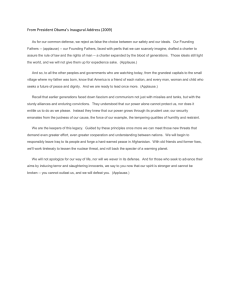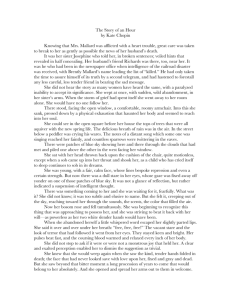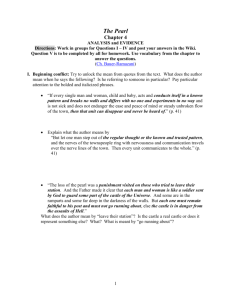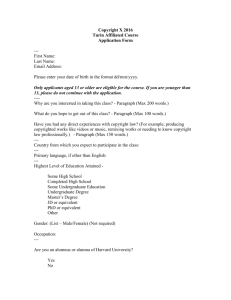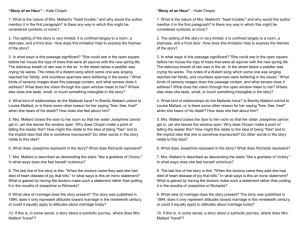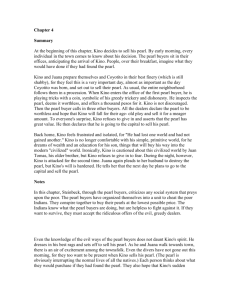Symbolism & Style - Gordon State College
advertisement
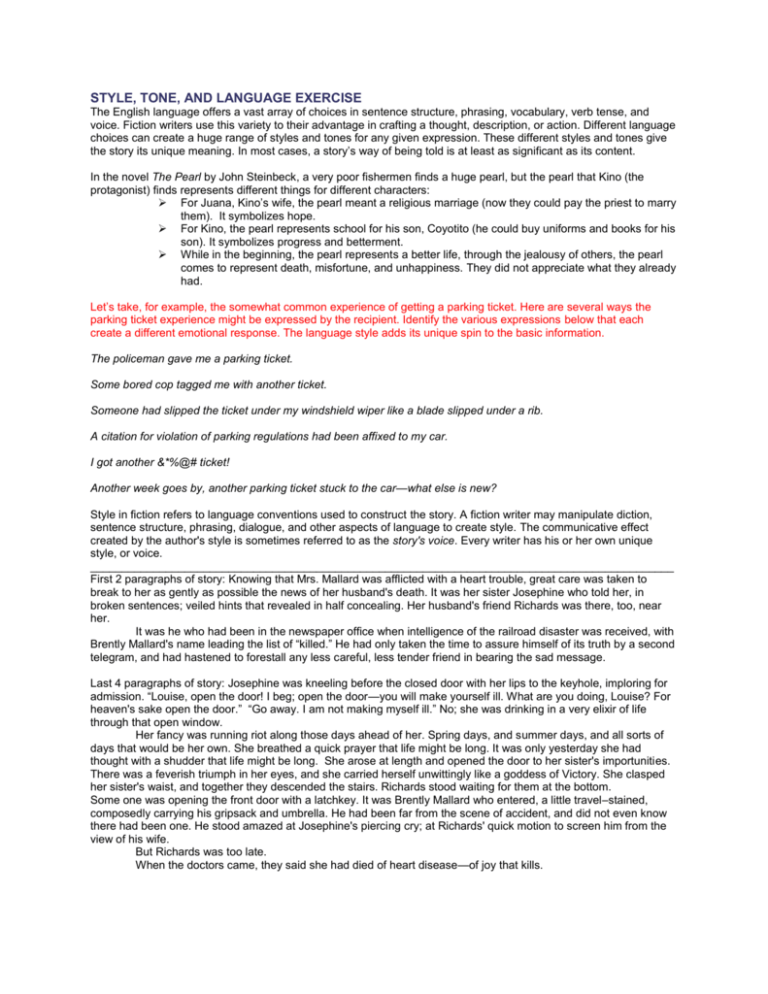
STYLE, TONE, AND LANGUAGE EXERCISE The English language offers a vast array of choices in sentence structure, phrasing, vocabulary, verb tense, and voice. Fiction writers use this variety to their advantage in crafting a thought, description, or action. Different language choices can create a huge range of styles and tones for any given expression. These different styles and tones give the story its unique meaning. In most cases, a story’s way of being told is at least as significant as its content. In the novel The Pearl by John Steinbeck, a very poor fishermen finds a huge pearl, but the pearl that Kino (the protagonist) finds represents different things for different characters: For Juana, Kino’s wife, the pearl meant a religious marriage (now they could pay the priest to marry them). It symbolizes hope. For Kino, the pearl represents school for his son, Coyotito (he could buy uniforms and books for his son). It symbolizes progress and betterment. While in the beginning, the pearl represents a better life, through the jealousy of others, the pearl comes to represent death, misfortune, and unhappiness. They did not appreciate what they already had. Let’s take, for example, the somewhat common experience of getting a parking ticket. Here are several ways the parking ticket experience might be expressed by the recipient. Identify the various expressions below that each create a different emotional response. The language style adds its unique spin to the basic information. The policeman gave me a parking ticket. Some bored cop tagged me with another ticket. Someone had slipped the ticket under my windshield wiper like a blade slipped under a rib. A citation for violation of parking regulations had been affixed to my car. I got another &*%@# ticket! Another week goes by, another parking ticket stuck to the car—what else is new? Style in fiction refers to language conventions used to construct the story. A fiction writer may manipulate diction, sentence structure, phrasing, dialogue, and other aspects of language to create style. The communicative effect created by the author's style is sometimes referred to as the story's voice. Every writer has his or her own unique style, or voice. _____________________________________________________________________________________________ First 2 paragraphs of story: Knowing that Mrs. Mallard was afflicted with a heart trouble, great care was taken to break to her as gently as possible the news of her husband's death. It was her sister Josephine who told her, in broken sentences; veiled hints that revealed in half concealing. Her husband's friend Richards was there, too, near her. It was he who had been in the newspaper office when intelligence of the railroad disaster was received, with Brently Mallard's name leading the list of “killed.” He had only taken the time to assure himself of its truth by a second telegram, and had hastened to forestall any less careful, less tender friend in bearing the sad message. Last 4 paragraphs of story: Josephine was kneeling before the closed door with her lips to the keyhole, imploring for admission. “Louise, open the door! I beg; open the door—you will make yourself ill. What are you doing, Louise? For heaven's sake open the door.” “Go away. I am not making myself ill.” No; she was drinking in a very elixir of life through that open window. Her fancy was running riot along those days ahead of her. Spring days, and summer days, and all sorts of days that would be her own. She breathed a quick prayer that life might be long. It was only yesterday she had thought with a shudder that life might be long. She arose at length and opened the door to her sister's importunities. There was a feverish triumph in her eyes, and she carried herself unwittingly like a goddess of Victory. She clasped her sister's waist, and together they descended the stairs. Richards stood waiting for them at the bottom. Some one was opening the front door with a latchkey. It was Brently Mallard who entered, a little travel–stained, composedly carrying his gripsack and umbrella. He had been far from the scene of accident, and did not even know there had been one. He stood amazed at Josephine's piercing cry; at Richards' quick motion to screen him from the view of his wife. But Richards was too late. When the doctors came, they said she had died of heart disease—of joy that kills. In Kate Chopin’s “The Story of an Hour”, the author uses positive images associated with the window and the natural world that feels just out of reach for the character to contrast the plot. This creates a sense of irony for the character because she cannot have the freedom she thought she was getting with the news of her husband’s death, which turned out to be false and put her back into the role of wife, which she felt trapped in. “There stood, facing the open window, a comfortable, roomy armchair. Into this she sank, pressed down by a physical exhaustion that haunted her body and seemed to reach into her soul. She could see in the open square before her house the tops of trees that were all aquiver with the new spring life. The delicious breath of rain was in the air. In the street below a peddler was crying his wares. The notes of a distant song which some one was singing reached her faintly, and countless sparrows were twittering in the eaves. There were patches of blue sky showing here and there through the clouds that had met and piled one above the other in the west facing her window.” The theme of the story is Identity and Selfhood. Chopin deals with the issues of female selfdiscovery and identity in "The Story of an Hour." After Mrs. Mallard learns of her husband's death, she is initially overcome with grief. But quickly she begins to feel a previously unknown sense of freedom and relief. This demonstrated how the role of wives at the turn of last century was more restrained and less free. SYMBOLISM EXERCISE An image is a sensory impression used to create meaning in a story. For example, near the beginning of "Young Goodman Brown," we see Faith, Brown's wife, "thrust her own pretty head into the street, letting the wind play with the pink ribbons of her cap." While visual imagery such as this is typically the most prominent in a story, good fiction also includes imagery based on the other senses: sound, smell, touch, and taste. If an image in a story is used repeatedly and begins to carry multiple layers of meaning, it may be significant enough to call a symbol. Symbols are often objects, like a toy windmill or a rose, or they may be parts of a landscape, like a river. While a normal image is generally used once, to complete a scene or passage, a symbol is often referred to repeatedly and carries meanings essential to the story. Some symbols are universal, like water for cleansing, Writers use preexisting cultural associations as well as meanings drawn from the context of the story to create multiple levels of meaning. Faith's pink ribbons in "Young Goodman Brown" carry cultural connotations of innocence and purity, but the fact that the wind plays with the ribbons in one key image also brings to mind temptation, alluring chaos, the struggle with natural forces. Red is also a significant color in the story's final temptation scene, with its basin of "water, reddened by the lurid light? Or was it blood?" Faith's pink ribbons carry, of course, a tinge of red. Symbols often carry multiple meanings in a story. For example, a simple lamp, if worked into the story’s setting and plot appropriately, might signify knowledge, personal warmth, and hope all at once. The lamp might also function literally as a lamp—perhaps as something bought at a yard sale. This multiple layering of meaning is what gives many symbols their artistic power. Select each item from the list below and imagine a different meaning or what it might mean in a story: a child accidentally lets go of a red balloon a snake a kite gets tangled in a tree a howling wind a kite with a broken tail that cannot fly an open window an old dusty piano a hotrod a tube of red lipstick a fountain a rose a bowl of fruit (real) a bowl of fruit (plastic)
